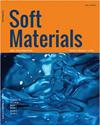石墨烯对近距离A到手性近距离C*相变的影响
IF 1.4
4区 材料科学
Q4 MATERIALS SCIENCE, MULTIDISCIPLINARY
引用次数: 1
摘要
摘要研究了石墨烯纳米颗粒与铁电液晶混合物中的SmA–SmC*相转变。将各向同性混合的Flory–Huggins自由能和Landau理论相结合,解释了石墨烯纳米颗粒对SmA–SmC*相变的影响。讨论了石墨烯纳米颗粒的温度和浓度对SmA–SmC*相变中近碳相倾斜角、自发极化和介电常数的依赖性。理论结果与实验结果在定性上一致。本文章由计算机程序翻译,如有差异,请以英文原文为准。
Effects of graphene on the smectic-A to chiral smectic-C* phase transition
ABSTRACT The smectic-A to chiral smectic-C* (SmA–SmC*) phase transition in the mixture of graphene nanoparticles and ferroelectric liquid crystal is studied. Combination of Flory–Huggins free energy of isotropic mixing and Landau theory is applied to explain the effects of graphene nanoparticles on the SmA–SmC* phase transition. The temperature and concentration of graphene nanoparticles dependence of tilt angle, spontaneous polarization and dielectric susceptibility in the smectic-C* phase of the SmA–SmC* phase transition are discussed. A qualitative agreement between theoretical results and experimental results is found.
求助全文
通过发布文献求助,成功后即可免费获取论文全文。
去求助
来源期刊

Soft Materials
工程技术-材料科学:综合
CiteScore
2.90
自引率
0.00%
发文量
21
审稿时长
2.2 months
期刊介绍:
Providing a common forum for all soft matter scientists, Soft Materials covers theory, simulation, and experimental research in this rapidly expanding and interdisciplinary field. As soft materials are often at the heart of modern technologies, soft matter science has implications and applications in many areas ranging from biology to engineering.
Unlike many journals which focus primarily on individual classes of materials or particular applications, Soft Materials draw on all physical, chemical, materials science, and biological aspects of soft matter. Featured topics include polymers, biomacromolecules, colloids, membranes, Langmuir-Blodgett films, liquid crystals, granular matter, soft interfaces, complex fluids, surfactants, gels, nanomaterials, self-organization, supramolecular science, molecular recognition, soft glasses, amphiphiles, foams, and active matter.
Truly international in scope, Soft Materials contains original research, invited reviews, in-depth technical tutorials, and book reviews.
 求助内容:
求助内容: 应助结果提醒方式:
应助结果提醒方式:


